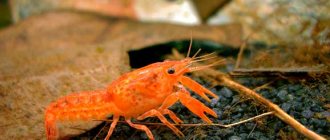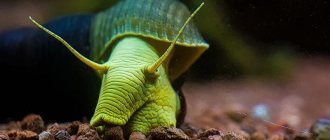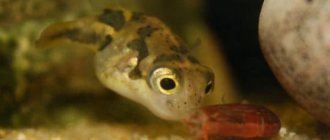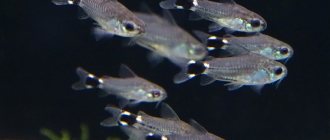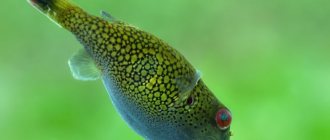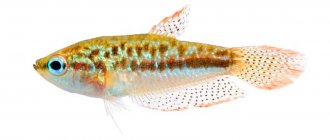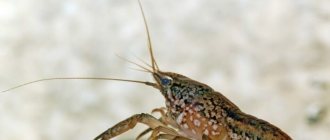General information
Mexican dwarf crayfish (Cambarellus patzcuarensis var. Orange) is a freshwater crustacean from the order Decapod crayfish.
You can also find the designation based on the first letters of the Latin name - CPO cancer. This Central American resident is distinguished by its miniature size, ease of care and feeding, as well as its stunning orange or red body color. All this makes it an ideal candidate for keeping in home aquariums. Adding to its popularity is the fact that the crayfish does not have to be kept in a species aquarium: it gets along well with both some popular fish and living plants.
It is worth noting that the beautiful orange “skin” of the Mexican dwarf crayfish is the result of the work of breeders, because in nature such colors will make it an easy prey for predators. In the aquarium, he has no one to fear, so crayfish continue to delight us with their bright outfits.
Interesting forms of behavior are also characteristic of crayfish: “arranging” their shelter, regular molting, mating and bearing offspring, skirmishes for territory. And what about the moment when the cancer is hungry - it runs along the wall of the aquarium, raising its claws. These pets love to hang upside down, clinging to the stems of plants; such a “ritual” can last several hours and sometimes confuses novice crayfish breeders.
Mexican dwarf crayfish are diurnal, which makes them easy to observe in a home aquarium. Rarely does an aquarium animal bring such a storm of emotions and surprise.
Molting crayfish
It's no secret that all crustaceans molt periodically. And orange cancer is no exception. Replacing the old chitinous shell with a new one is the only way to grow. Juveniles molt frequently, about once a week. Adult dwarf crayfish molt less frequently. During the molting period, it is especially important for crayfish to have a shelter where the animal remains until its new shell hardens. Also, molting is a way to restore lost limbs. Crayfish lose them under a variety of circumstances (the claws are most often affected). The cancer can also lose its legs during the molting itself - if the cancer cannot remove any limb from the old shell, it tears it off or chews it off. In both the first and second cases, this phenomenon is called autotomy. In general, if you suddenly see a crayfish with one claw, don’t worry, it will soon grow back during the next molt.
The success of molting depends on many factors. One of them is the presence of calcium in water. Calcium is the basis of chitin for the shell. An element such as iodine is also very important. It is a coenzyme for the synthesis of chitin. With iodine deficiency, there is a high probability that the cancer will not be able to molt and will die. Therefore, if crustaceans live in your aquarium, iodinol is your best friend. Of the branded drugs, we can recommend Tetra Vital , which also contains iodine.
Appearance
If you have ever seen a common crayfish, then it will not be difficult for you to imagine the appearance of the hero of the article. The body consists of sections characteristic of crustaceans: a dense cephalothorax and a mobile abdomen ending in a wide caudal fin. The first section serves as a place for attaching walking legs (five pairs, the first ends with massive tentacles), jaws and sensory organs. Under a dense shell (carapace), the internal organs of the cancer are reliably protected. The abdomen consists of articulated segments, under which are located swimming legs - pleopods. They participate not only in swimming, but also in reproduction. For example, in a male, one of the pairs has turned into a copulation organ, and females use them to carry eggs and young crustaceans.
The most popular body color is red-orange, the intensity of which can vary. There may be dark or light stripes along the head and tail, as well as small round spots. Body length does not exceed 5 cm.
Life expectancy in aquarium conditions is 2-3 years.
Habitat
As you can easily guess from the name, the homeland of dwarf cancer is Mexico. One of the most famous places of distribution is the volcanic lake Lago de Patzcuaro (Mexican Pacific coast), which is located at an altitude of 2000 m above sea level, so the water in it remains relatively cool even in summer.
Crayfish live mainly in stagnant bodies of water, or in streams and rivers with a gentle current. They stay near the shores, because this is where it is easiest to find suitable shelters among the roots of trees or rocks of the coastline.
Care and maintenance
To keep a pair of Mexican dwarf crayfish you will need an aquarium of at least 50 liters. It is best if it has the maximum bottom area, because this is where almost the entire life of crayfish passes.
Coarse sand or medium pebbles are suitable as soil. It is better to make the layer thicker, since crayfish really like to dig up the bottom.
An aquarium with Mexican dwarf crayfish should have a large variety of hiding places. This will help your pet to divide the territory if several individuals live in a container, to hide during molting, when the unhardened cover is very vulnerable, and for females to preserve offspring. Any available materials are suitable as shelters: grottoes, ceramic pots, hollow tubes with a diameter of 2-5 cm, coconut shells, etc. Often, crayfish make an impromptu door near the entrance to the shelter - they rake up a mound of soil, which closes the entrance when they leave the house, dig it up, and bury it again upon returning.
The aquarium must be equipped with a filter. This is necessary to maintain cleanliness and high quality water, because crayfish are sensitive to high levels of nitrogen compounds. It is better to give preference to internal filters. This is due to the fact that Mexican crayfish are excellent climbers. They can easily climb the external filter tubes and escape through the technological openings. Unfortunately, such a journey will be fatal for the crayfish if it is not returned to the aquarium in time, since they cannot live long without water. Particular attention must be paid to aeration. For crayfish, oxygen dissolved in water is vital, so it is worth choosing filters with air supply, or even better, installing a separate compressor. The problem of lack of oxygen is especially pressing in the summer, because it dissolves much less well in warm water.
Mexican dwarf crayfish are good with living plants. The only threat is the possibility of digging up the roots. Most often, unpretentious plant species are recommended: tufts of Java moss, hornwort, cryptocoryne, ferns. It is advisable to place limnobium, pistia or riccia on the surface of the water - they create natural twilight, since crayfish do not like bright lighting.
Once a week, you should replace 20% of the water in the aquarium with fresh water, and tap water must be prepared using Tetra Crusta AquaSafe conditioner, which will remove compounds dangerous to crayfish from the water.
The water for keeping crayfish should not be too soft, since arthropods require minerals to form a shell.
Optimal water parameters for keeping: T=18-25°C, pH=7.0-8.5, GH=10-20.
One of the features of keeping crayfish is their periodic molting. It consists of shedding the old cover, which no longer allows the cancer to grow, and forming a new one; during this period, the crustaceans increase in size until the shell hardens. During this time, Mexican dwarf crayfish are the most vulnerable, because without a protective cover, even peace-loving fish species can offend them, not to mention their own relatives. Molting also allows the crayfish to grow new limbs that were lost in battles when crayfish were kept in groups. It is very important not to throw away the discarded cover from the aquarium; it will be eaten by the owner, and its nutritional elements will be used to build new “clothes”.
Painted dwarf crayfish (Cambarellus texanus)
Painted dwarf crayfish (Cambarellus texanus)
Other names: Texas Dwarf Crayfish; Brazos Dwarf Crayfish.
Size
S - up to 2 cm, M - up to 3 cm, L - up to 3 cm, XL - up to 4 cm, XXL - up to 4 cm.
Habitat
Southwestern North America, Texas (USA) between the Lavaca River and Lavaca Bay in the west and the Brazos River basin in the east; also found in the Colorado River. The northern limit of distribution is not precisely determined.
Description
Closely related to the Louisiana crayfish, these two members of the same family, Cambarellus, are easily confused. The color of both representatives varies greatly: from red and red-brown to gray and grey-brown. There are many beautiful curved, wavy and dotted lines running along the back of the crayfish. In the center of the swamp crayfish's tail there is a clearly visible dark spot. The claws of the swamp crayfish have an elegant, elongated and narrow shape.
Keeping in an aquarium
Water parameters: Temperature from +16C to +28C. The minimum temperature of water may drop to +4C, because... in its range in February the air temperature drops to -2C. pH 6.5-8.5 (optimum – 7.5) gH | kH - feels comfortable in water of medium hardness, although it adapts to different levels, because lives in drying up reservoirs4. gH: min – 8С, optimum – 13, maximum – 18 kH: Water volume: min – 20 l.
Soil: either special for aquariums or regular sand or gravel. Food: omnivorous detritivore. Eats any plant and animal waste and any aquarium food that it collects at the bottom. No feeding is required in a community aquarium. When kept in a monoculture, feed 3-4 times a week. It is desirable to have oak leaves, Indian almonds or alder cones in the aquarium.
Compatibility
Not aggressive, timid. They get along with small fish and, if there is sufficient bottom area, with micro-shrimp. Does not damage living plants. Uses thickets as a refuge during the molting period.
Breeding
It’s not complicated and doesn’t require any special conditions. Males are characterized by a more slender body, long legs and elongated claws; instead of the first pair of swimming legs there are hooked gonopods2,4. Females are larger, stronger, have shorter legs and are more timid; when manipulated, they actively tuck their tail between their legs. Sex ratio: 1 male: 2-3 females. Sexual maturity: 3 months (upon reaching a size of 2.5-3 cm)4 Development cycle: direct freshwater, juveniles are born as copies of adults, independent from birth. Number of eggs: 10~25, depending on the age of the female. Duration of egg development: ~25 days.
Feeding
Crayfish is omnivorous, the menu range is extremely wide from branded dry food to the tricks of individual cuisine - boiled shrimp, sea fish meat, snails. Successfully competes for food with its neighbors: fish and shrimp.
Compatibility
Mexican dwarf crayfish are distinguished by their peaceful nature. Intraspecific aggression does occur, but it tends to zero in the absence of overpopulation and a large number of diverse shelters. In such situations, even possible fights end happily.
Cancers have a calm relationship with Pisces. Most often, it happens that mobile neighbors are an additional source of stress for crayfish, which, when they appear, try to hide in a shelter as quickly as possible. Even long-term cohabitation with the same species does not make arthropods less fearful.
On the other hand, a hungry crayfish will move like a tank towards the coveted food, pushing aside even fish larger than itself.
Medium-sized active fish are best suited for keeping together: mollies, platies, barbs. Relationships with bottom fish are also usually good, despite the need to share the territory, so corydoras, thoracatums, and ancistrus can be housed with crayfish without fear.
Undesirable species include various cichlids (black-striped cichlid, severum, acara, astronotus, etc.), as well as shrimp and crabs.
Feeding the Mexican dwarf crayfish
Feeding the Mexican dwarf crayfish is the least of the problems when keeping it. These animals are completely omnivorous; the origin of food does not matter to them. Dead parts of plants, dead fish, dry food - all this will be eaten by cancer with pleasure. It is better not to use widely available live and frozen foods; they do not contain the full range of nutrients needed by cancer, and in addition, they can spoil the water very quickly if they are not completely eaten by pets.
It is best to opt for high-quality dry crustacean food Tetra Crusta. These fully balanced feeds will provide the crayfish with everything it needs, including nutrients for good molting. They quickly sink to the bottom and retain their shape for a long time, which makes it possible to feed crayfish even in community aquariums. At the same time, the food does not cause cloudiness in the water and deterioration in its quality. Also, crayfish will perfectly eat universal food for catfish and bottom fish - Tetra WaferMix or Tetra Pleco SpirulinaWafers.
Additionally, you can feed the crayfish with dried oak or Indian almond leaves.
Contents of dwarf crayfish
Dwarf Mexican crayfish is undemanding in maintenance. A couple of crustaceans will live quite comfortably in a 50-liter aquarium. However, if you want to keep more than four dwarf crayfish, then a 100 liter aquarium will be just right. The soil can be anything, plants, driftwood, grottoes, stones, and other shelters are mandatory conditions for their maintenance, since crayfish need places where they can hide, this is especially important during molting, when the crayfish becomes completely defenseless. In addition, females with eggs also need shelter. The water temperature for keeping dwarf crayfish is 25-27 degrees, make sure that it does not rise above 28. “Water acidity” (pH) is optimally 7.5-8. Carbonate hardness (kN) should be at least 6. Crayfish will live in soft and acidic water, but not for long. If your region has soft water and you are going to keep crayfish, the problem can be solved by placing a piece of limestone or chalk in the aquarium.
Crayfish are extremely sensitive to increased concentrations of nitrogen compounds (NH4, NO2, NO3) , so you should not put them in a newly started aquarium. From the above it follows that good filtration and aeration are required. Weekly water changes are also necessary. With their help, we reduce the concentration of nitrogen compounds and, moreover, molting and mating season are usually timed for water changes in crayfish.
Is it possible to keep dwarf orange crayfish in a community aquarium with fish? Undoubtedly! But there are some nuances. platies , mollies , and others that prefer a pH around 7.5 - are ideal as neighbors The fish should not be large and aggressive (for example, cichlids).
